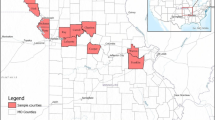Abstract
Changes in extreme events may represent an important component of climate change impacts on agricultural systems in California. This study considered the relative historical importance of extreme events, as measured by insurance and disaster payments. The causes for each main event for 1993–2007 were classified into general categories to compare the importance of dry vs. wet and hot vs. cold events. The study found that the most common cause of both insurance indemnity and disaster payments is excess moisture, followed by cold spells and heat waves. Climate change is likely to have different effects on the occurrence of each of these, for instance with frosts becoming less common while heat waves increase in frequency and duration. Resolving the overall net effect of changes in climate extremes will largely depend on improved understanding of future risks of excess rainfall and flooding events.


Similar content being viewed by others
References
Alexander LV et al (2006) Global observed changes in daily climate extremes of temperature and precipitation. J Geophys Res 111:D05109. doi:10.1029/2005JD006290
Kiktev D, Sexton DMH, Alexander L, Folland CK (2003) Comparison of modeled and observed trends in indices of daily climate extremes. J Climate 16(22):3560–3571
Meehl GA et al (2007) Global Climate Projections. In: Solomon S et al (eds) Climate change 2007: the physical science basis. Contribution of Working Group I to the fourth assessment report of the intergovernmental panel on climate change. Cambridge University Press, Cambridge and New York
Moser S, Kasperson R, Yohe G, Agyeman J (2008) Adaptation to climate change in the Northeast United States: opportunities, processes, constraints. Mitig Adapt Strat Glob Chang 13(5):643–659
O’Gorman PA, Schneider T (2009) The physical basis for increases in precipitation extremes in simulations of 21st-century climate change. Proc Natl Acad Sci 106(35):14773
Rosenzweig C, Tubiello FN, Goldberg R, Mills E, Bloomfield J (2002) Increased crop damage in the US from excess precipitation under climate change. Global Environ Change-Hum Policy Dimensions 12(3):197–202
Tebaldi C, Hayhoe K, Arblaster JM, Meehl GA (2006) Going to the extremes. Clim Chang V79(3):185–211
White MA, Diffenbaugh NS, Jones GV, Pal JS, Giorgi F (2006) Extreme heat reduces and shifts United States premium wine production in the 21st century. Proc Natl Acad Sci 103(30):11217
Wolfe D et al (2008) Projected change in climate thresholds in the Northeastern US: implications for crops, pests, livestock, and farmers. Mitig Adapt Strat Glob Chang 13(5):555–575
Acknowledgments
We thank the U.S. Department of Agriculture’s Risk Management Agency and the National Oceanic and Atmospheric Administration for providing data used in this report. This work was supported by a grant from the California Energy Commission’s Public Interest Energy Research (PIER) Program.
Author information
Authors and Affiliations
Corresponding author
Rights and permissions
About this article
Cite this article
Lobell, D.B., Torney, A. & Field, C.B. Climate extremes in California agriculture. Climatic Change 109 (Suppl 1), 355–363 (2011). https://doi.org/10.1007/s10584-011-0304-5
Received:
Accepted:
Published:
Issue Date:
DOI: https://doi.org/10.1007/s10584-011-0304-5




